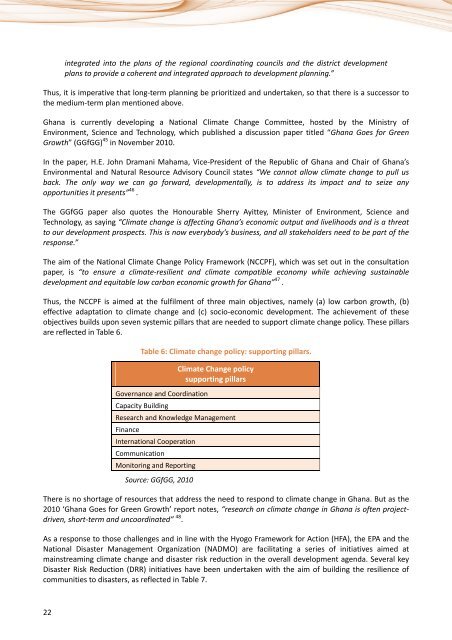Information and communication technologies (ICTs) and ... - ITU
Information and communication technologies (ICTs) and ... - ITU
Information and communication technologies (ICTs) and ... - ITU
You also want an ePaper? Increase the reach of your titles
YUMPU automatically turns print PDFs into web optimized ePapers that Google loves.
integrated into the plans of the regional coordinating councils <strong>and</strong> the district development<br />
plans to provide a coherent <strong>and</strong> integrated approach to development planning.”<br />
Thus, it is imperative that long-term planning be prioritized <strong>and</strong> undertaken, so that there is a successor to<br />
the medium-term plan mentioned above.<br />
Ghana is currently developing a National Climate Change Committee, hosted by the Ministry of<br />
Environment, Science <strong>and</strong> Technology, which published a discussion paper titled “Ghana Goes for Green<br />
Growth” (GGfGG) 45 in November 2010.<br />
In the paper, H.E. John Dramani Mahama, Vice-President of the Republic of Ghana <strong>and</strong> Chair of Ghana’s<br />
Environmental <strong>and</strong> Natural Resource Advisory Council states “We cannot allow climate change to pull us<br />
back. The only way we can go forward, developmentally, is to address its impact <strong>and</strong> to seize any<br />
opportunities it presents” 46 .<br />
The GGfGG paper also quotes the Honourable Sherry Ayittey, Minister of Environment, Science <strong>and</strong><br />
Technology, as saying “Climate change is affecting Ghana’s economic output <strong>and</strong> livelihoods <strong>and</strong> is a threat<br />
to our development prospects. This is now everybody’s business, <strong>and</strong> all stakeholders need to be part of the<br />
response.”<br />
The aim of the National Climate Change Policy Framework (NCCPF), which was set out in the consultation<br />
paper, is “to ensure a climate-resilient <strong>and</strong> climate compatible economy while achieving sustainable<br />
development <strong>and</strong> equitable low carbon economic growth for Ghana” 47 .<br />
Thus, the NCCPF is aimed at the fulfilment of three main objectives, namely (a) low carbon growth, (b)<br />
effective adaptation to climate change <strong>and</strong> (c) socio-economic development. The achievement of these<br />
objectives builds upon seven systemic pillars that are needed to support climate change policy. These pillars<br />
are reflected in Table 6.<br />
Table 6: Climate change policy: supporting pillars.<br />
Climate Change policy<br />
supporting pillars<br />
Governance <strong>and</strong> Coordination<br />
Capacity Building<br />
Research <strong>and</strong> Knowledge Management<br />
Finance<br />
International Cooperation<br />
Communication<br />
Monitoring <strong>and</strong> Reporting<br />
Source: GGfGG, 2010<br />
There is no shortage of resources that address the need to respond to climate change in Ghana. But as the<br />
2010 ‘Ghana Goes for Green Growth’ report notes, “research on climate change in Ghana is often projectdriven,<br />
short-term <strong>and</strong> uncoordinated” 48 .<br />
As a response to those challenges <strong>and</strong> in line with the Hyogo Framework for Action (HFA), the EPA <strong>and</strong> the<br />
National Disaster Management Organization (NADMO) are facilitating a series of initiatives aimed at<br />
mainstreaming climate change <strong>and</strong> disaster risk reduction in the overall development agenda. Several key<br />
Disaster Risk Reduction (DRR) initiatives have been undertaken with the aim of building the resilience of<br />
communities to disasters, as reflected in Table 7.<br />
22

















